Android Central Verdict
The Samsung Galaxy Watch 5 Pro isn't actually designed for professional athletes like the name implies, whether you consider its dense design or lack of Garmin-esque fitness guidance. Samsung justifies the weight (and high price) with an impressive three-day battery lifespan and a gorgeous 1.4-inch display. In most respects, it's very similar to the cheaper Galaxy Watch 5, but has a few upgrades up its sleeve, making it the "best" Wear OS watch around.
Pros
- +
Durable titanium case and sapphire glass
- +
Battery life lives up to the hype
- +
Extremely fast 10W charging
- +
Blazing performance on One UI Watch 4.5
- +
Redesigned sensor array for more accurate results
- +
Google Assistant available at launch
Cons
- -
Too thick for sleep tracking
- -
Too heavy for comfortable all-day use
- -
Not enough differences between Pro and standard GW5
- -
Default band has issues for athletes
- -
Temperature sensor still not active months later
Why you can trust Android Central
Since it launched the Galaxy Watch Active 2 in 2019, Samsung continued to improve its Samsung Health software, but never sold another "fitness watch" despite its success. Enter the Samsung Galaxy Watch 5 Pro, a name marketed to attract serious athletes away from beloved, expensive brands like Garmin.
While the standard Galaxy Watch 5 made very few changes from 2021's excellent Galaxy Watch 4, the Galaxy Watch 5 Pro completely threw off the yolk of the Classic design found on old Samsung watches. Instead of a rotating bezel, it uses luxury titanium and sapphire materials, adds a bulky battery built to last, and features a couple of fitness tools not found on the smaller watch.
I'll say upfront that the Galaxy Watch 5 Pro isn't for everyone thanks to its polarizing design. Even "pro" athletes should carefully consider whether Samsung actually caters its software enough to their needs. But you can at least rest assured that this expensive, stocky watch has the zippy performance, gorgeous display, third-party app support, and durable design that we've come to expect from Samsung watches.
Samsung Galaxy Watch 5 Pro: Price and availability

The 45mm Samsung Galaxy Watch 5 Pro shipped on August 26, 2022, for $450 at most major retailers. Unlike the more colorful Galaxy Watch 5, it's only available in Black Titanium or Gray Titanium.
You can choose five different types of watch bands: the magnetized D-Buckle Sport described in this review, a colorful Global Goals band for which Samsung will donate money to the UNDP if you select it, and three different types of Sport bands designed for more breathability and exact fits.
If you want to upgrade to the 4G/LTE Galaxy Watch 5 Pro, you'll pay an extra $50, bringing the total to $500. Or, you can buy the Galaxy Watch 5 Pro Golf Edition for $500; it only comes in a Black Titanium finish, and offers unique golf software tools.
As of this review update, you'll find several major Galaxy Watch 5 Pro deals available at Samsung, carriers like AT&T and Verizon, and retailers like Best Buy. They may not last through the holidays, but at the moment, you'll find enhanced trade-in value and even some buy-one-get-one-free offers.
Samsung Galaxy Watch 5 Pro: Design and Display

Samsung claims the Galaxy Watch 5 Pro is a sleek 10.5mm thick in its press releases, an absurdly misleading claim with a footnote that this measurement doesn't include the health sensors. You can't remove the health sensors, which add another 4.5mm or so by my tape measure; the only potential reason for not including them is that Samsung was worried consumers would be turned off by how thick the watch is.
The deception aside, my gray titanium model still manages to look fairly stylish because the black sensor undercarriage blends in from my perspective, so I only really notice that 10.5mm portion. Others will prefer the all-black model for its uniformity, though I personally find it too boringly reminiscent of other fitness watches.
The Galaxy Watch 5 Pro is thicker, heavier, and more boring-looking than the Galaxy Watch 4 Classic.
Whatever your aesthetic leanings, there's no doubt the Galaxy Watch 5 Pro juts out from your wrist, and it has the weight to match. Again, Samsung used some creative arithmetic to claim it only weighs 46.5 grams/1.64 ounces, neglecting to mention its actual weight is about 73 grams/2.58 ounces with the magnetic D-Buckle Sport band.
I've gotten used to wearing "heavy" Garmin watches in the 45-50 grams range (with bands), but the Galaxy Watch 5 Pro gives a whole new meaning to the word. Choosing one of the other Galaxy Watch 5 Pro bands of a lighter material could alleviate some of the added weight a bit.
With a watch this thick, I can guarantee it'll catch on doorways or furniture at some point, not to mention taking damage during a run or gym workout. This makes the inclusion of titanium materials and hard sapphire display glass a welcome addition, along with the raised case bezel that protects the slightly dipped display from most direct hits.
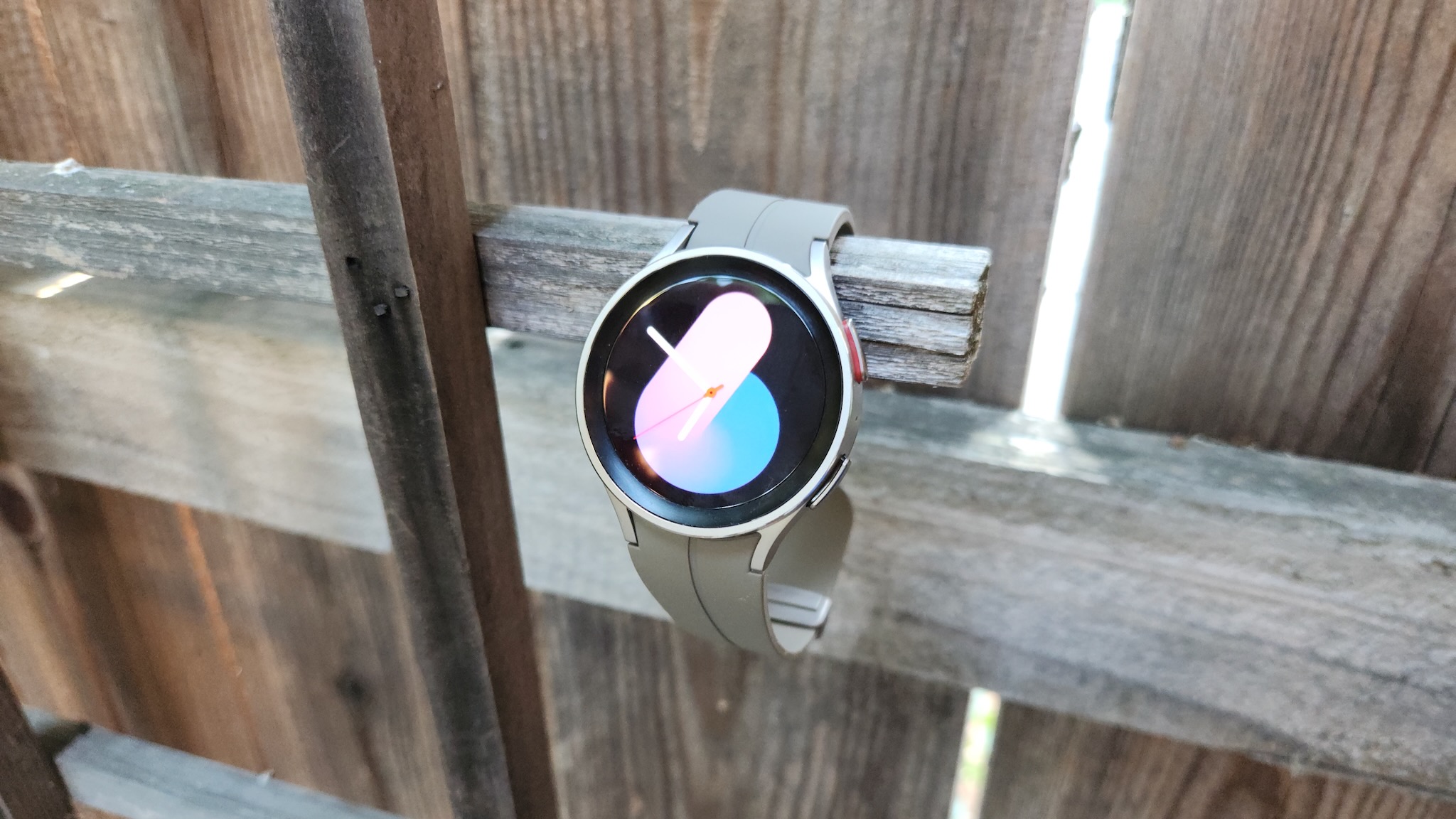
In this case, we have to take Samsung at its word that the glass is 60% harder than the Galaxy Watch 4 display. I have to return the Pro after my review, and I'm not going to risk bashing it against a rock to test Samsung's claims. But so long as you're not reckless with it, the Galaxy Watch 5 Pro does appear to be built to last.
Overall, because I'm used to thick Garmin watches in the 12-13mm range that cater to "pros," I don't mind its thick look, even if I find its girth annoying for sleep tracking because it forces my wrist away from the pillow. For everyday use, its weight starts to feel a bit oppressive after a full day of wearing it while typing over a keyboard. And while I don't mind the athletic-style design, anyone used to lifestyle watches will probably find it too thick to be attractive.
| Category | Samsung Galaxy Watch 5 Pro |
|---|---|
| Display | 1.4″ (34.6mm) 450×450 Super AMOLED |
| Dimensions | 45.4 x 45.4 x 15mm |
| Weight | 46.5 grams/1.64 ounces (without band) |
| Processor | Exynos W920 Dual-Core 1.18GHz |
| Memory | 1.5GB RAM + 16GB internal storage |
| Battery | 590mAh; 80-hour estimate with light use |
| Charging | 10W USB-C |
| OS/UI | Wear OS 3.5 with One UI Watch4.5; requires Android 8.0 phone or higher |
| Sensors | Samsung BioActive Sensor (Optical Heart Rate + Electrical Heart Signal + Bioelectrical Impedance Analysis), Temperature Sensor, Accelerometer, Barometer, Gyro Sensor, Geomagnetic Sensor, Light Sensor |
| Connectivity | Bluetooth 5.2, Wi-Fi 802.11 a/b/g/n 2.4+5GHz, NFC, GPS/Glonass/Beidou/Galileo, LTE (optional) |
| Durability | 5ATM + IP68 / MIL-STD-810H |
Because of these circumstances, it makes sense that Samsung ditched the rotating bezel of the Galaxy Watch 4 Classic, since that would have added even more grams and millimeters to an already chunky design. Instead, you rotate your finger along the display's bezel edge to quickly slide through menus. This works as intended for at-home use, but less so when your fingers are sweaty during or after a workout (more on that note in the fitness section below).
The display itself, a 1.4-inch 450×450 Super AMOLED, looks fantastic, whether in terms of color, brightness, or refresh rate. It's able to display very small text and icons while they're still fully readable, and the touchscreen is accurate enough that you can type on the new One UI 4.5 keyboard despite the limited screen real estate.
Of course, it has the same resolution as the Galaxy Watch 5 44mm, so you can still get the same visual quality for about $140 less. But I don't think it needs to be any better than this, especially as it would get in the way of battery life for minimal gains.
Samsung Galaxy Watch 5 Pro: D-Buckle Sport band

Before we proceed with your regularly-scheduled Galaxy Watch 5 Pro review, we have to talk briefly about the D-Buckle Sport band that comes with it. It has a magnetic clasp that holds the watch firmly in place, so the band has a sleek, uniform look without the usual adjustment holes found on athletic watches.
Before I start my complaints, I'll give Samsung credit: Once you find the proper band placement for your wrist size, you can easily un-attach and reattach the band from your wrist without having to find the right fit over and over again. The clasp attaches firmly so the watch itself can stay in place while giving your skin some breathing room.
My main issue with the design boils down to the fact that a "Pro" fitness watch doesn't need or want breathing room. A fit that's comfortable during the workday will lead to wobbling during a run.
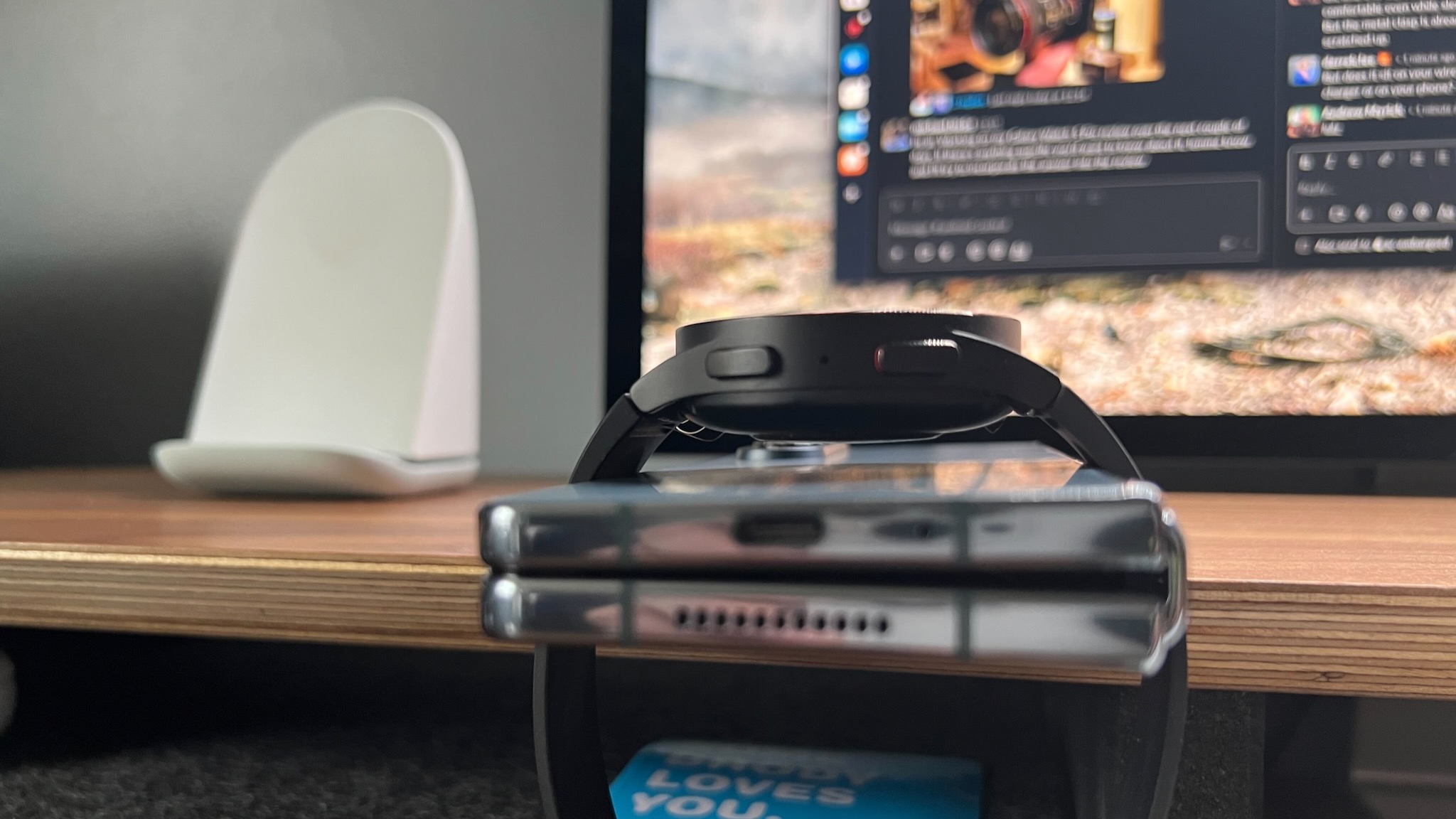
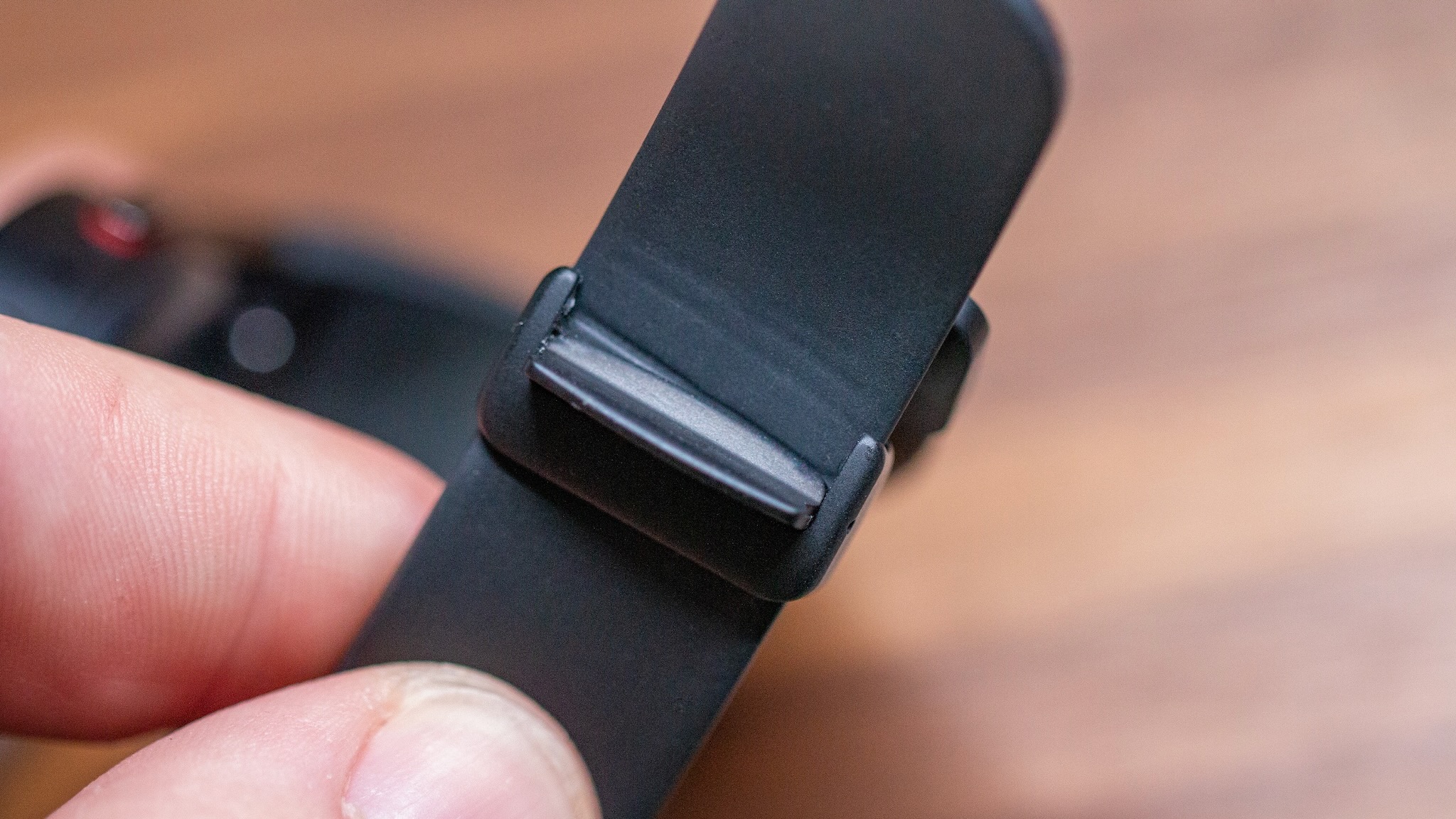

To adjust your fit, you have to force open the clasp flap — not an easy task — feed a bit more watch band through, push down the clasp, and then close it around your watch and hope that you got the fit right. There's no easy way to know for sure until that moment, which means lots of time-consuming readjustments.
Plus, the clasp flap digs into the watch band, causing permanent indentations wherever you adjust it. I can only assume that this will have a negative effect on the band's longevity and look over time.
The other side effect of the D-Buckle Sport band design is that it doesn't allow the Pro to sit flush against anything, which means you can't actually use your Samsung phone's reverse wireless charging to top off your Galaxy Watch 5 Pro. Samsung eventually released a Galaxy Watch Charging Cradle that lets you charge it while it sits upright, but without it you'll have to rely on the included cable.
Samsung Galaxy Watch 5 Pro: Wear OS 3 performance
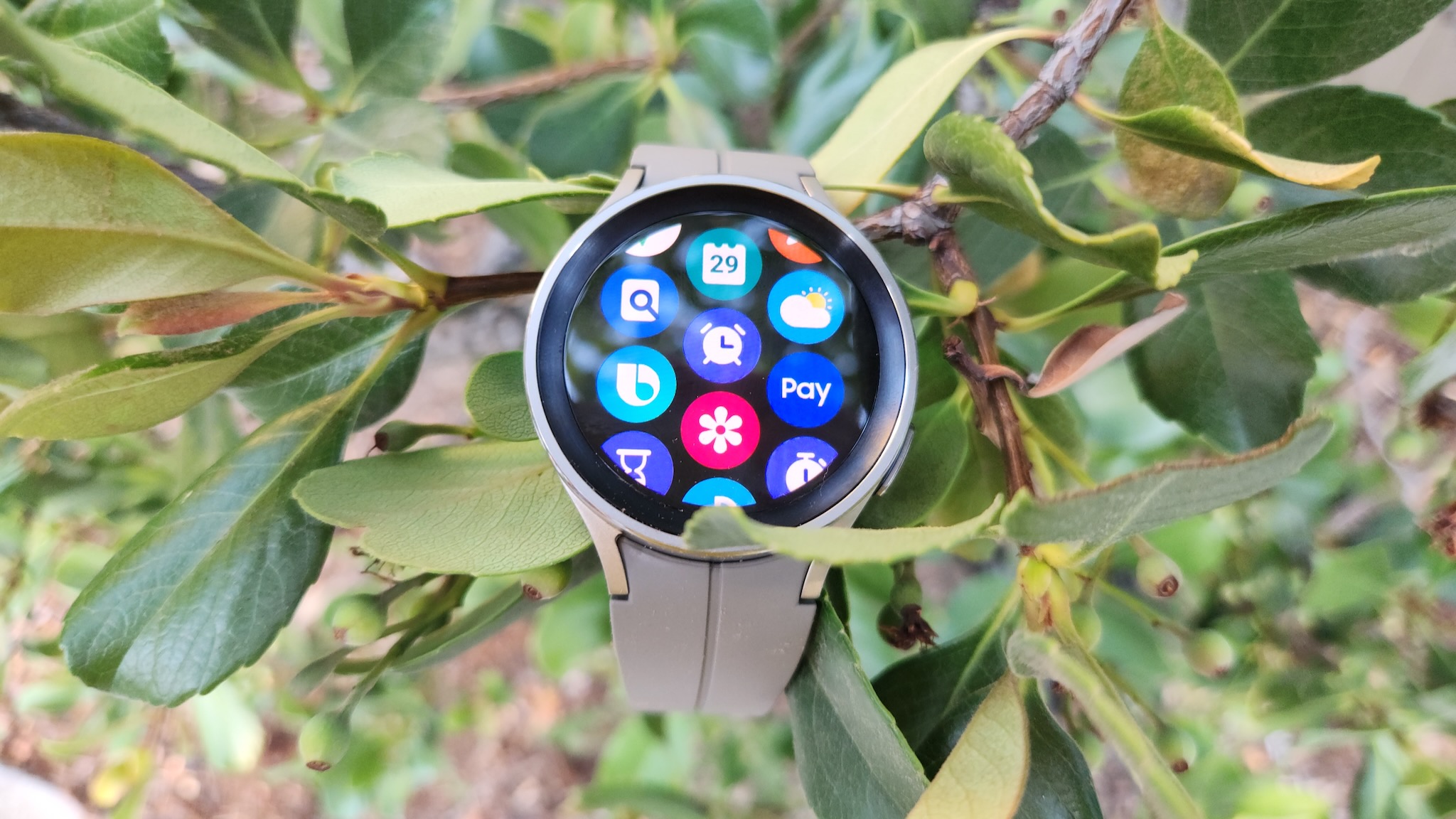
Samsung used the same Exynos chip in the first three Galaxy Watches before upgrading to the Exynos W920 with the Galaxy Watch 4. You might look askance at Samsung for bringing back the same chip this year, but watch chips don't advance at the same frantic rate as phone chips, and Apple is guilty of the same practice. I wouldn't be surprised if Samsung used the same chip and 1.5GB of memory in the Galaxy Watch 6 as well, so don't hold off if long-term performance is your concern.
Samsung watches continue to dominate the Wear OS space for performance and features.
The fact is, I can simply sum up the Galaxy Watch 5 performance with this quote from our Galaxy Watch 4 review: "When you ask the watch to do something, it just does it." I've gotten so used to a bit of lag after every action on a Garmin or Fitbit watch that the immediate response to any tap or swipe is a huge breath of fresh air.
Since there honestly isn't much else to say on the speed front, let's talk about Wear OS 3.5 and One UI Watch 4.5. Most of its changes focus on accessibility, letting you change the display's hue and contrast, disable animations, adjust watch face information, or otherwise improve visual information that's difficult for disabled users to read or use. In many ways, it's the same interface that Galaxy Watch 4 owners have used since 2021.

One cool new addition is a QWERTY keyboard for typing out Messages to friends. I don't know how well it would work on the 40mm Galaxy Watch 5, but the 1.4-inch Watch 5 Pro display seems to have just enough room that my careful hen-and-pecking or swiping from one key to the next works about 70% of the time. If you plan to buy the LTE version, or want to text without taking out your phone, you'll appreciate this option.
Of course, you can also rely on Google Assistant (or Bixby) to transcribe messages if you don't want to bother with it. After the painful nine-month wait for Assistant on the Galaxy Watch 4, it's nice to have it available from jump as a button shortcut (since the always-listening function burns through battery).
Alongside the Pixel Watch launch, Google brought Google Maps to Wear OS, and it's a nice addition to the Galaxy Watch 5 Pro with its larger screen. The watch app retains your saved addresses from your Google account, but you can also search for new locations with the mic or keyboard. Choose a transportation method — walking, cycling, or driving — and start a route, and the watch will vibrate whenever you reach a junction. You can display the next step as text or show the map, as you prefer.
We'll also note that the Pixel Watch has a more Material You-esque UI, while the Galaxy Watch 5 uses Samsung's distinct style that's arguably a bit less memorable.
Wear OS is an interface that improves the more time you spend in the settings. I love the option to create dozens of customized watch faces with different complications, or to rearrange which tiles appear first when I swipe through them. I disliked how it defaulted back to the main watch face after 20 seconds, so I found a setting that leaves the last app or screen queued up for up to an hour. I won't bore you with my other list of changes like vibration intensity, but the level of personalization you can add is refreshing compared to an interface like Garmin's, which only lets you save one custom watch face at a time.
Samsung Galaxy Watch 5 Pro: Battery life and sleep tracking
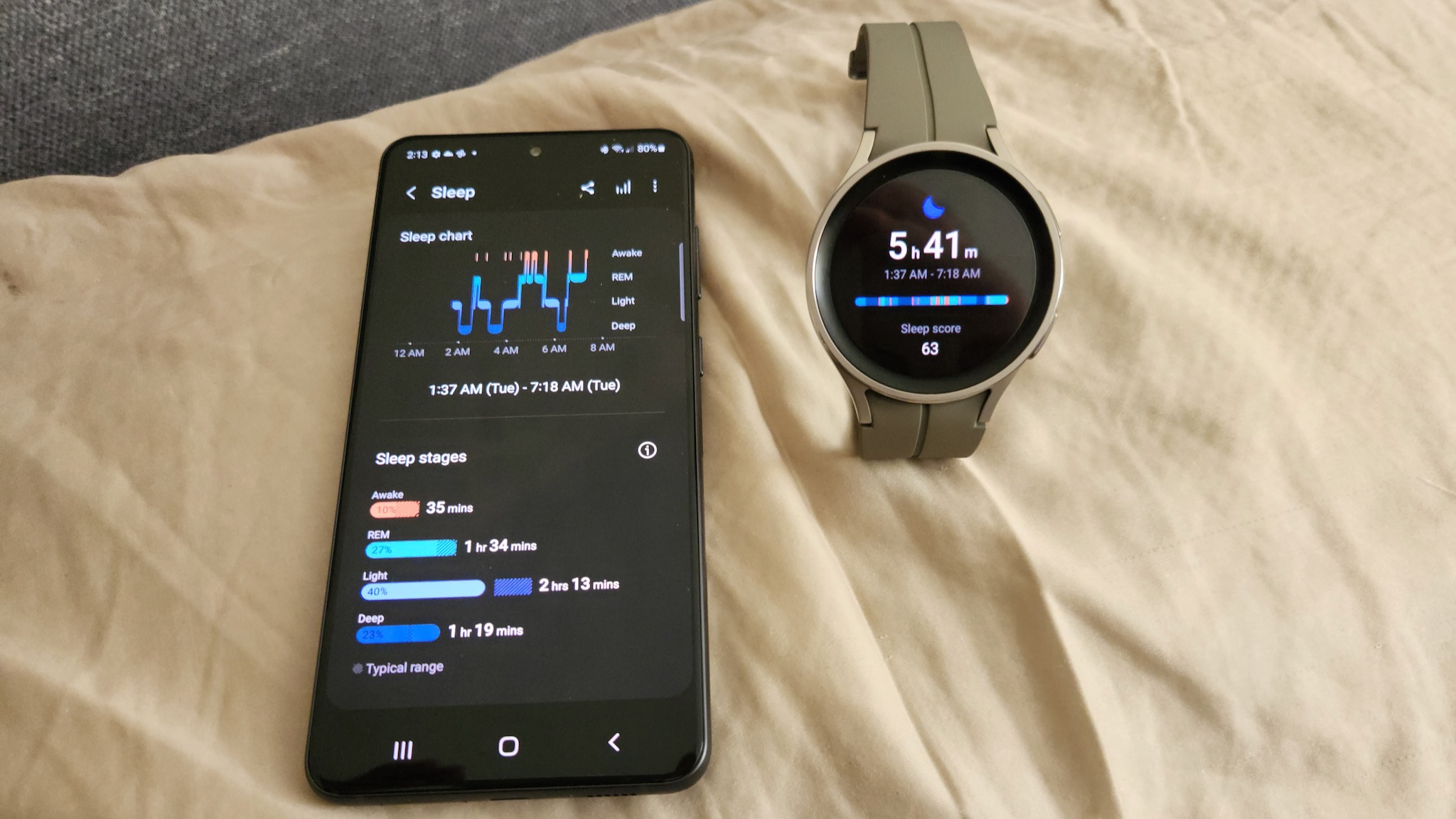
If you're asking yourself why you should buy the Galaxy Watch 5 Pro when it's so much heavier and more expensive than the base GW5, there's one clear answer: the battery life. Samsung claims it'll last 80 hours per charge, compared to 40 hours for the standard Galaxy Watch 5. And while your Pro won't actually last three or more days if you activate core features like continuous heart rate, Always-On Display (AOD), always-listening Google Assistant, or daily GPS tracking, it comes pretty darn close.
Battery measurements are always relative based on your habits, favorite apps, and so on. So I pooled my other coworkers who either bought or received the Galaxy Watch 5 Pro for themselves, so I could see how their experience compared with mine:
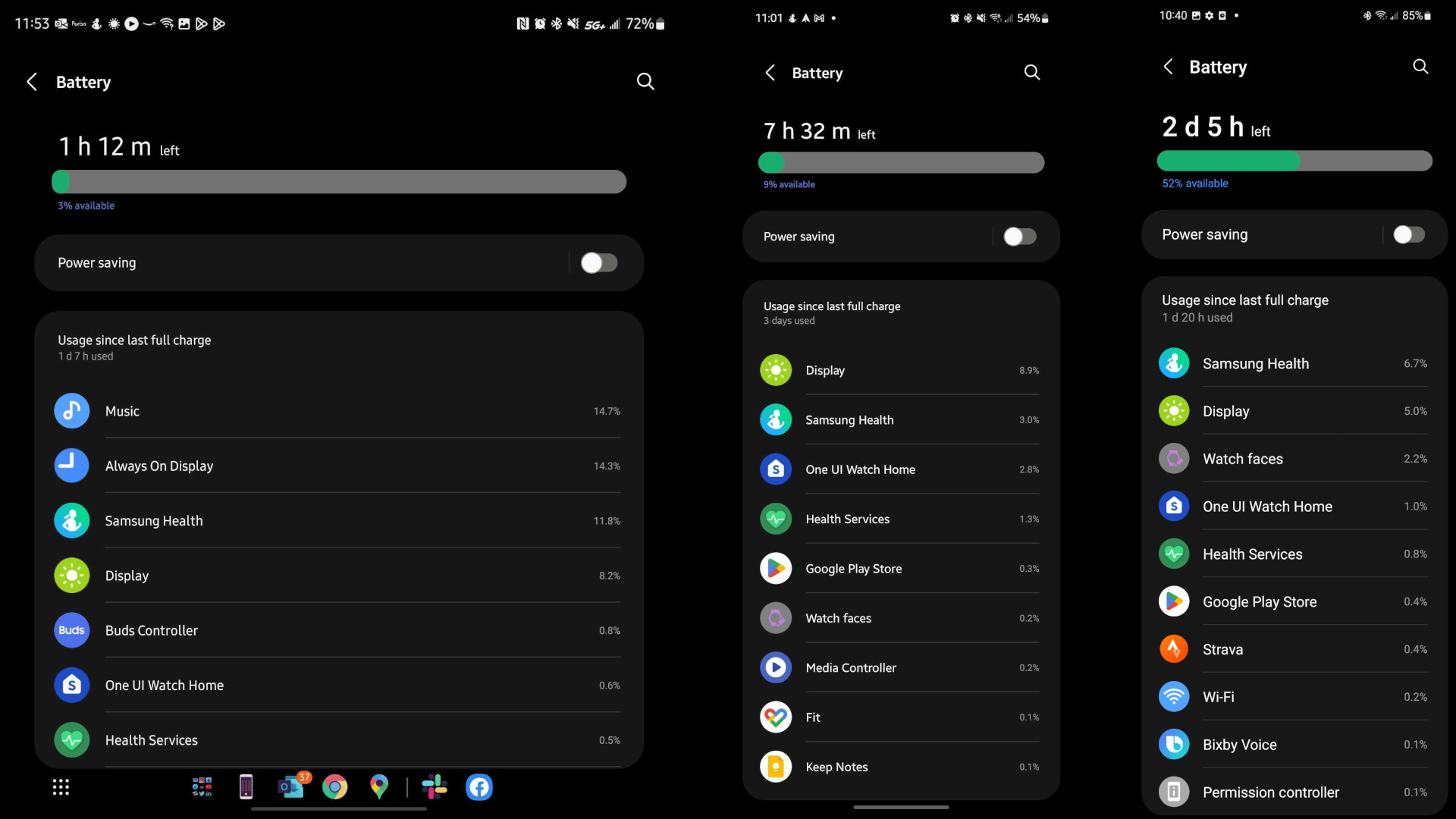
After 31 hours with continuous HRM and SpO2, AOD, three hours of music streamed to the Buds 2 Pro, 30 minutes of GPS hiking with route guidance, two one-hour sessions of GPS workout tracking, and one night of sleep and snore detection, my coworker's Galaxy Watch 5 Pro finally ran out of juice. I can guarantee most other lifestyle watches would last half that time (or less) with that kind of hardcore use.
With more casual habits — 24/7 HRM and SpO2 and sleep/workout tracking, but no AOD or music streaming — the Galaxy Watch 5 Pro actually stays on pace to last the full 80-hour duration that Samsung promises.
No other lifestyle watch comes close to the Galaxy Watch 5 Pro in battery life.
As for charging speed, the Galaxy Watch 5 and 5 Pro really benefit from the upgrade to 10W charging. While the smaller 5 can jump to nearly 100% in an hour, the 5 Pro has a lot more battery to charge, so it'll take closer to two hours to fully fill back to capacity. If you just need to top off before bed, it charges very quickly from low battery, about 30% in just 20 minutes. In theory, that'd be enough for a whole day of continuous HRM, SpO2, sleep tracking, and light app usage.
Outside of some workhorse Mobvoi models, Wear OS watches typically manage to last 24 hours per charge, give or take. Even the upcoming Pixel Watch is rumored to need 30% battery to get through a single night of sleep tracking. With the Pro, I found that seven hours of sleep tracking (with both HRM and SpO2 active) would only drain about 7% of the battery. That's either absurdly efficient or just an indicator of how massive the 590mAh battery is, but I appreciate it regardless.
Of course, I don't know how the new temperature sensor will affect battery life, since Samsung has yet to activate it. In theory, it's supposed to "provide users with an in-depth understanding of their wellness" and give accurate readings by differentiating between your body temperature and that of the surrounding room. But the fact that Samsung talked up the temperature sensor in its pre-release marketing but hasn't activated it months after launch looks really bad for the company.

After you track your sleep for seven nights, Samsung will give you feedback on your sleep habits with a cute animal icon and a summary of your habits. It'll then invite you to use its sleep coaching program with daily sleep missions, so you'll form better habits and become a more well-rested animal than a "sensitive hedgehog" or "exhausted shark."
I struggled to make it a full week of sleep tracking because the Watch 5 Pro just isn't that comfortable to wear at night. To be fair, I have this issue with most watches, but the Pro is thick enough that it still digs into my skin even with my pillow lessening the pressure a bit. And the aforementioned D-Buckle Sport band leaves enough give between skin and watch that I don't get particularly accurate blood oxygen results.
If you are genuinely interested in Samsung's revamped sleep tracking features, then you'd probably want to go with the base Galaxy Watch 5, if at all. It's also pretty thick at about 13mm, but even that 2mm difference will help you find a more comfortable sleeping position. And it's lighter, which helps it feel like less of a burden to wear on your wrist all day.
Samsung Galaxy Watch 5 Pro: Workout and health tracking

After reviewing watches from Garmin, Fitbit, Polar, Coros, and Amazfit, suddenly jumping onto a Wear OS watch led to some mental readjustments on my part. I've gotten used to limited operating systems that cater solely to fitness software, only to jump into a free-for-all Android ecosystem with more options, more apps, and more clutter. This isn't a bad thing, just different.
Wear OS has plenty of excellent running apps like Strava, Nike Run Club, Adidas Running, and Map My Run, so you can cut out the middleman instead of having to export your data from one app to the next. So I focused my testing on Samsung Health tools to see what, exactly, makes this watch a good fit for "pros." To do so, I matched it up against the Garmin Forerunner 255, an excellent runners' watch that certainly fits that category.

Samsung has dozens of exercise modes ranging from proper sports (running, cycling, swimming) to specific exercises (jumping jacks, planking, arm curls), each with a cute animation and specific Settings which let you set goals prior to a workout.
Workouts that can be easily measured by the watch's gyroscope, like jumping jacks, can have specific rep targets and will buzz your wrist when it registers one completed. Or, for running, you can set a goal based on calories, distance, or intervals. But for more complicated or freeform exercises, it'll only measure calories and duration; the different labels are just for your own notes in the Health app.
In my time with the Galaxy Watch 5 Pro, I found that the ease of accessing these tools made me more likely to cross-train and complete exercises outside of just running, so that's certainly a point in the watch's favor.
Samsung Health is great for movement reminders, cross-training exercises, and health data...but less so for hardcore workout guidance.
I was intrigued by one specific exercise mode: Running Coach, which uses audio coaching to spur you on and complete workouts of varying difficulty. While the theory behind this tool is cool, I don't like that you can't change the parameters of a guided workout; the toughest run is only 5.37 miles, and most are far too easy for experienced runners to follow. Compared to Garmin Coach and the 255's daily suggested workouts, Samsung's coaching has better production value but less practicality or personalization.
I also appreciated the inactivity reminder, which encourages you to walk or complete a few exercises like squats. I only wish I could edit the frequency of reminders, or which exercises it prompts you to do, in case I want more challenging or persistent reminders while I'm stuck at my desk.
Otherwise, Samsung has the same issue as Apple, which is that it gives you a bunch of post-workout data and exercise rings to finish every day, but no context of how your body should be feeling after a workout. If I run a tough race, Garmin will inform me how it affected my conditioning and warn me to wait extra time for recovery before going out again; Samsung will congratulate me and then shame me for not putting just as much effort in the next day to get up and move, absent that context.

Samsung has multiple GNSS systems but, like most fitness watches, only relies on one signal at a time. Garmin's new watches can use multiple satellite systems and frequencies for much more accurate readings, so unsurprisingly its map of my run looks far more accurate while Samsung's tracked line frequently breaks off at odd angles when something interferes with the signal. Despite that, the two watches would buzz my wrist within a second of one another whenever I hit a mile marker, proving that Samsung's discrepancies don't actually cause the distance data to be that far off from reality.
Heart rate accuracy is always a bit difficult to judge, since any discrepancy could be the fault of one watch or the other. But given I found the Forerunner 255 to be pretty darn accurate in my past tests, I can tentatively say the Galaxy Watch 5 Pro underestimated my heart rate by a few bpm for both average and max readings, but on the whole it matched time in specific heart rate zones pretty darn well. It's possible that difference comes down to the D-Buckle Sport band not giving the Pro as tight of a fit, so the 255 pressed against my wrist gets slightly better results.
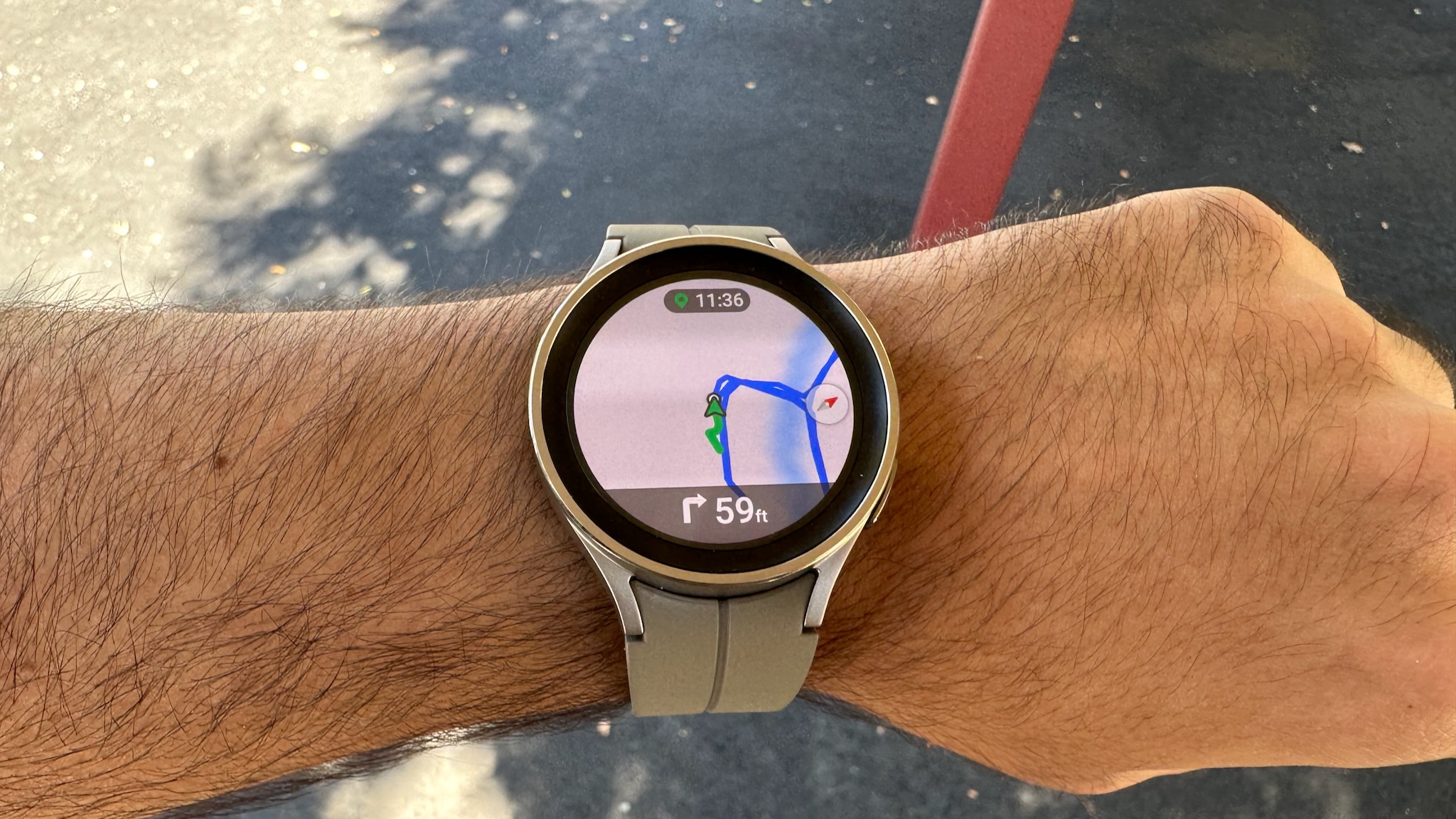
The Galaxy Watch 5 Pro has two exclusive fitness features over its cheaper sibling watch: downloadable GPX maps for hiking or cycling, and TrackBack navigation to guide you back home. The latter is a welcome addition you'll find on most advanced fitness watches these days, while the former is more of a niche tool. Now that the Galaxy Watch 5 supports Google Maps, you can get basic directions without having to download maps; but "pro" adventurers will appreciate offline maps since they let you follow directions even if you lose your cellular signal (or lose your phone).
One downside for serious athletes is its touchscreen-dependant navigation and touch bezel. Moving through menus with sweaty fingertips is an exercise in futility. During a workout, you have to swipe to find the pause option or find your heart rate data, because Samsung's two buttons don't have the same direct control over workout software as a dedicated fitness device would. And if you live in warm climates like me, you'll definitely have some dropped inputs and swipes over the course of a workout.
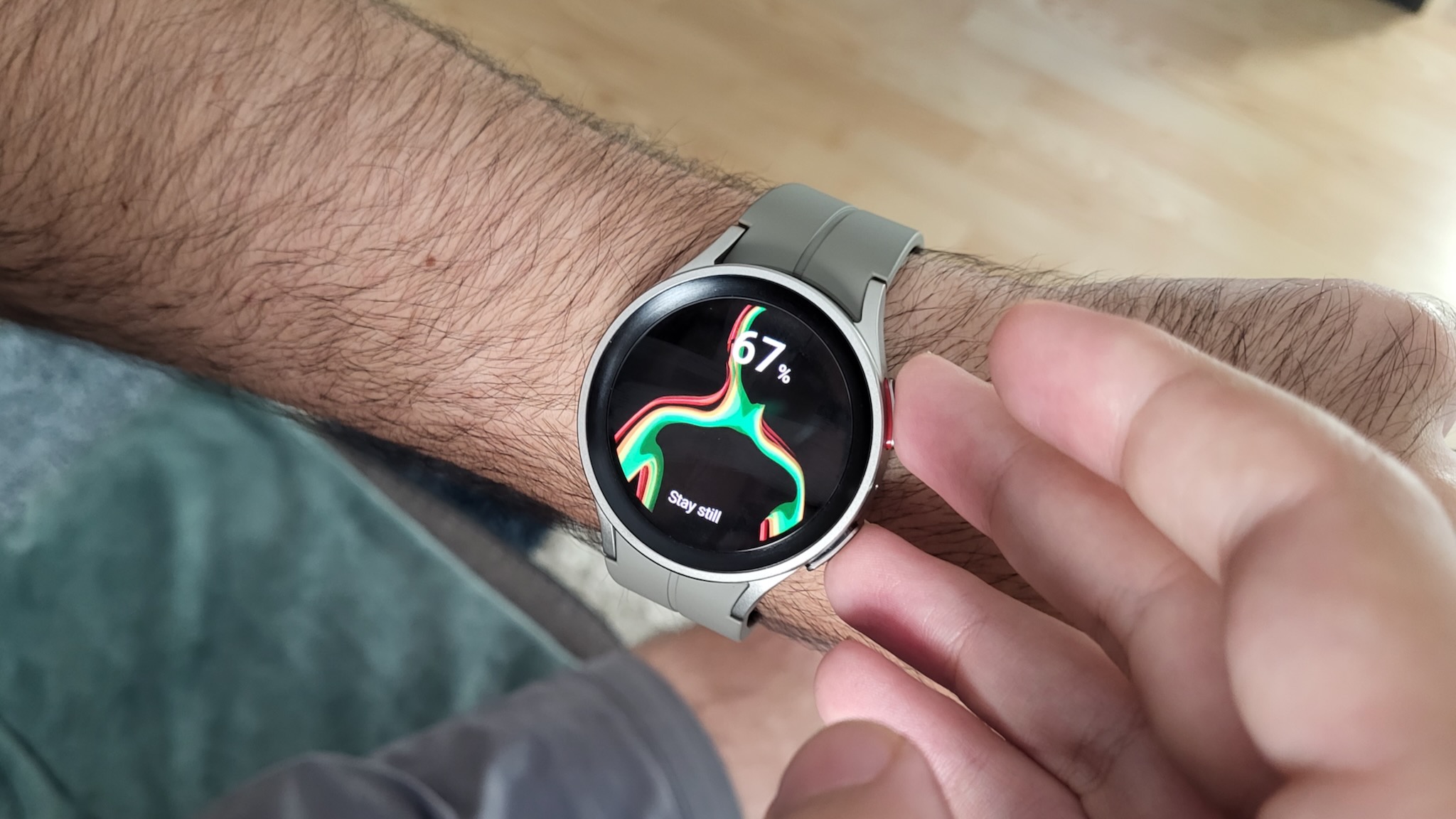
Where Samsung jumps ahead of Garmin — and most other brands — is in its sheer quantity of health data. The heart rate monitor tracks heart rate variance (HRV) for measuring daily stress, while blood oxygen tracking helps determine sleep energy recovery. Those are both industry-standard at this price, but its 3-in-1 sensor with ECG and Bioelectrical Impedance Analysis (BIA) will give you more accurate data on irregular heartbeats (AFib) and your body's current fat and muscle levels. Plus, international GW5 Pro buyers can enjoy testing blood pressure, something we still can't test in the States.
They're all the same health sensors as last year, not including the inactive temperature sensor. Last year's BIA readings tended to fluctuate from one to the next, whereas mine seemed to stay pretty consistent across several days. Samsung hasn't spent the last year twiddling its metaphorical thumbs, in other words; either the algorithm or the sensor has gotten more accurate than before.
Samsung Galaxy Watch 5 Pro: Competition
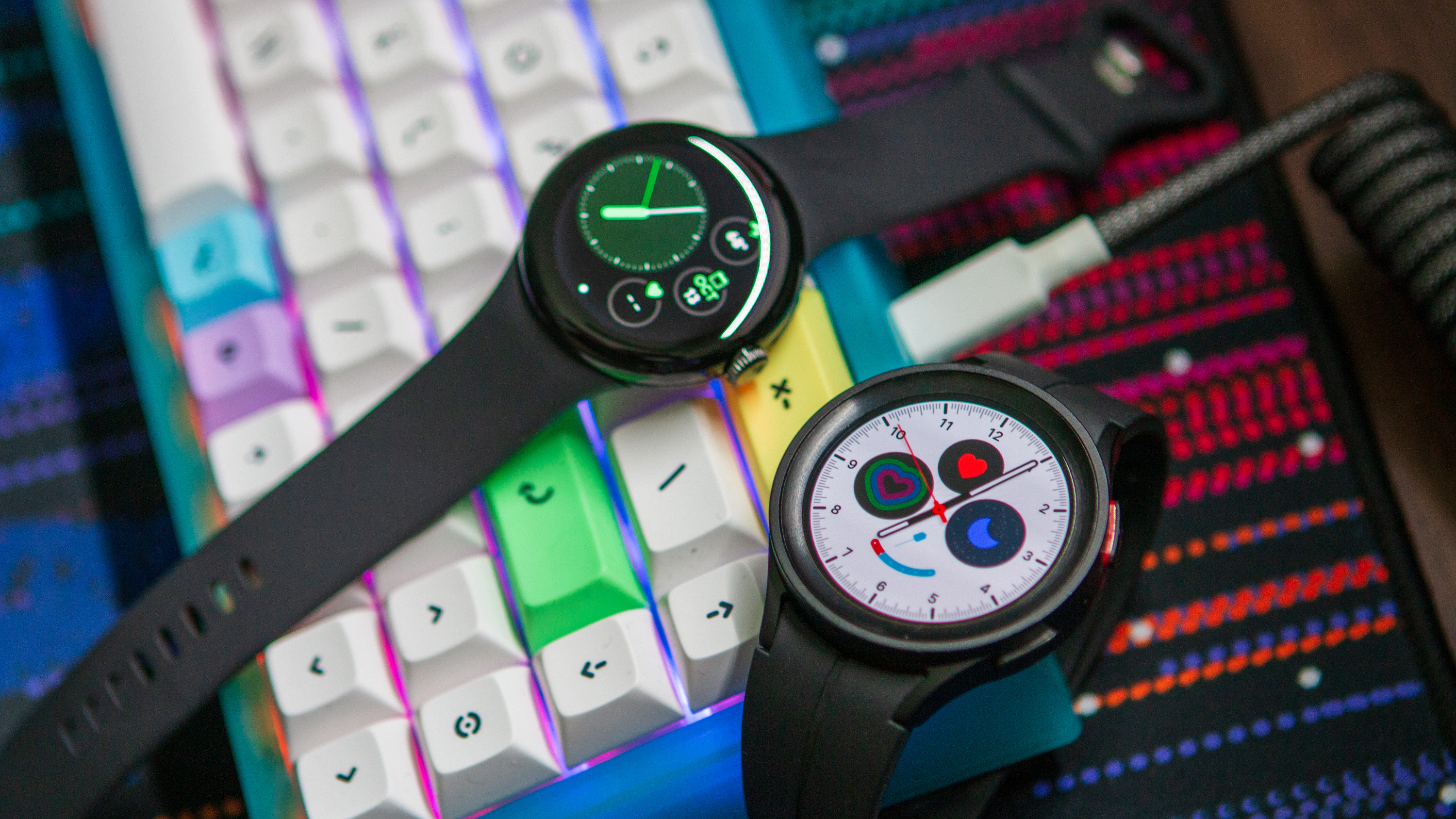
Samsung's biggest competition for the title of best Android smartwatch is with itself. The standard Galaxy Watch 5 is much more affordable with the exact same performance and storage space. The battery size is 284mAh on the 1.2-inch model or 410mAh on the 1.4-inch model, and our reviewer found that the watch would typically only last 24 hours with the same features enabled. That's why many will accept how heavy the Pro is, since it gives you that huge battery boost. But you should check our Galaxy Watch 5 vs. 5 Pro guide before you decide.
If, on the other hand, you're looking for a fitness smartwatch above all else, you'll want to look into Garmin. As I said, the Forerunner 255 has the most accurate data and best running coaching both during and after runs, but it's not exactly "smart" in other ways.
The Garmin Venu 2 Plus bridges the gap a bit, adding a beautiful AMOLED touchscreen, mic, and speaker, weighing much less than the Pro and lasting for 9 days per charge while costing the same. It just lacks proper third-party app support. Check our Galaxy Watch 5 Pro vs. Venu 2 Plus breakdown to see how they compare.
Of course, now that the Pixel Watch has arrived, Google fans may prefer it despite having fewer health sensors and a 24-hour battery life. Put plainly, its edge-to-edge display makes it much more attractive than the Galaxy Watch 5 series, and it's much lighter for daily use. Our versus guide will spell out all of the other differences.

The other competition is more hypothetical, since you can't use Galaxy Watches on iOS anymore. But the Apple Watch Ultra easily beats the Pro as a luxury fitness watch, giving you a more rugged design, rotating crown for more reliable controls, brighter display, better safety tools like an SOS function, a working temperature sensor, and built-in cellular data. Its 36-hour battery life falls short of the Pro, but it has better fitness-tracking tools with watchOS 9 that'll make it worth wearing for athletes.
Of course, the Apple Watch Ultra is ridiculously expensive even compared to the pricey Pro, so the more relevant comparison is against the Apple Watch Series 8. On that front, it's a more fair fight.
Samsung Galaxy Watch 5 Pro: Should you buy it?

You should buy the Galaxy Watch 5 Pro if...
- You want cutting-edge performance and visuals.
- You don't want to compromise on features and you hate recharging your watch.
- You own a Samsung phone, so you won't miss any exclusive features.
- You need a wide range of fitness apps and tools.
You shouldn't buy the Galaxy Watch 5 Pro if...
- Your sole focus is fitness and training tools.
- You want something light and comfortable for constant wear and sleep tracking.
- You're on a tight budget.
Don't put too much stock in the 4-star rating I gave the Galaxy Watch 5 Pro, because it was a struggle to grade. In some ways, it's a 5-star watch: It easily beats any non-Samsung Wear OS watch in quality and speed, the battery life is fantastic where the basic Galaxy Watch 5 falls short, and if you ignore the "Pro" name it genuinely does have some reliable fitness tools that are quite good for a non-specialized watch.
In other ways, it's more of a 3-star watch. It's hard to get past just how heavy this watch is, and how the design prevents wireless charging or comfortable sleep tracking. Aside from GPX maps that very few people will use, Samsung didn't put enough effort into advancing Samsung Health to make it more competitive with Garmin Connect, or to differentiate the Pro from the GW5 in software, not just hardware, to justify the higher cost.
So I just split the difference.
I've always been someone who wears fitness watches during runs and then taken them off afterwards, because they're just not worth wearing outside of workouts or attractive enough to make a fashion statement. With the Galaxy Watch 5 Pro, its deep app library gives me the motivation to keep it on, but the design of the watch itself saps my enthusiasm to keep it on for too long.
My coworker who reviewed the Galaxy Watch 5 decided to buy the Watch 5 Pro for himself, and loves it for the battery life. I think I'll take a reverse path and look into buying the Galaxy Watch 5 44mm or 40mm, so I can enjoy all of the same perks but give my wrist a bit of a break; the new charging speed is so fast that I don't think I'll resent the smaller battery.
If you can, see if you can find a store to try on both watches for yourself first, and see which is the better fit for you before buying the Galaxy Watch 5 or the Galaxy Watch 5 Pro. They're both great in their own way, but they may not be great for you.

3-day battery life
The Samsung Galaxy Watch 5 Pro abandons the 4 Classic's rotating bezel and keeps its old processor and memory. So why does it cost so much more? Because of its ridiculously long-lasting battery and stylish, durable materials that'll make the Pro last across sweaty workouts for years to come.
Review changelog
This review was originally published on September 10, 2022. It was updated in December 2022 with the following changes:
- Included ongoing Galaxy Watch 5 Pro deals.
- Added link guide on how to use GPX maps and noted new Google Maps app.
- Discussed Galaxy Watch Charging Cradle.
- Noted the ongoing absence of the new temperature sensor.
- Expanded Competition section with new rivals like the Pixel Watch and Apple Watch Ultra.

Michael is Android Central's resident expert on wearables and fitness. Before joining Android Central, he freelanced for years at Techradar, Wareable, Windows Central, and Digital Trends. Channeling his love of running, he established himself as an expert on fitness watches, testing and reviewing models from Garmin, Fitbit, Samsung, Apple, COROS, Polar, Amazfit, Suunto, and more.


